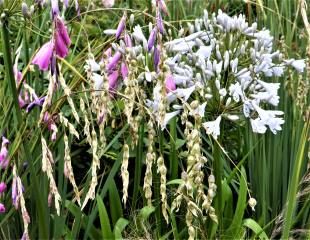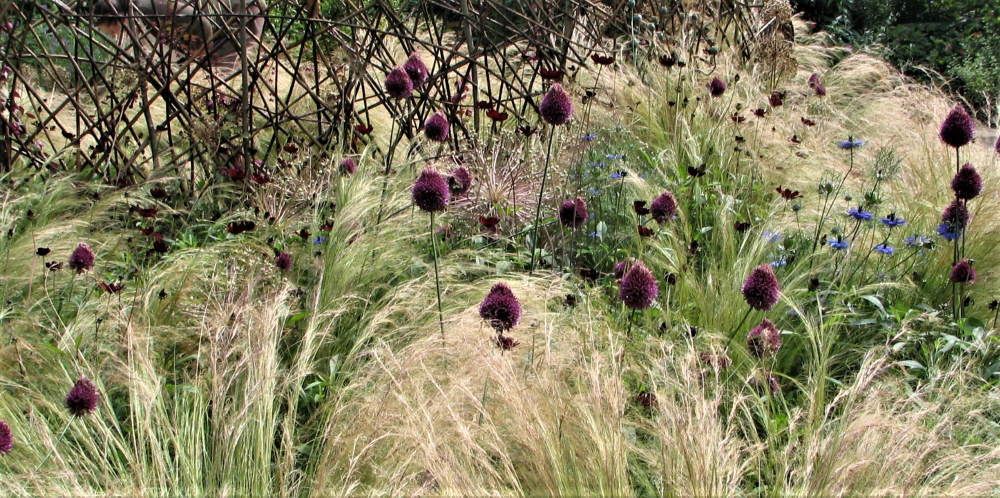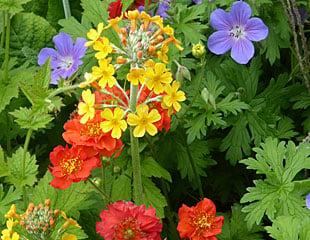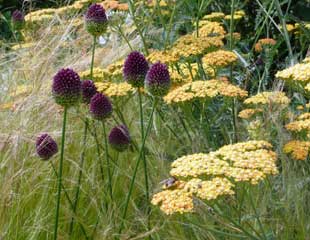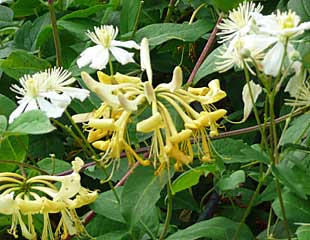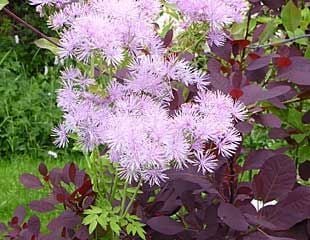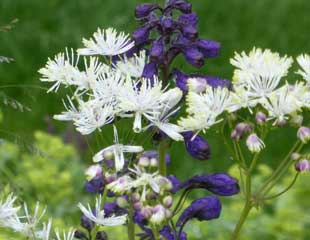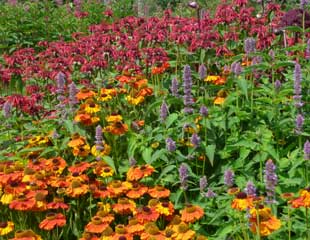Summer planting combinations and ideas
How you design and plant your garden, just like your home, is a question of personal taste and needs to suit you. Magazines and web sites can suggest planting combinations and some will catch your interest, others you may hate.
Here are lots of ideas for summer planting combinations from, which you can pick and mix what you like and fancy in your garden.
There are images and links to other pages with growing information, so you can decide if you like the plant and if it is right for your garden. Remember "right plant, right place"
Illustrated above first and left is a summer flowering combination of Delphiniums and Thalictrum, a soft blue and mauve combination. Delphiniums are a time-consuming plant to grow, but spectacular with their large, showy flower heads. Thalictrum is easy to grow, tall and graceful witha fluffy flower head one of my absolute garden favourites.
The Centre image is a more relaxed, semi-wild combination of purple Loosestrife and Meadow sweet, which are very attractive to pollinators and ideal if you are thinking of having a wild area in your garden.
The third image on the right is Dierama, common name Angel's Fishing Rod combined with Agapanthus. Neither plant is straightforward to grow, but if you have the right conditions, they will flourish together.
The garden is a wonderful place to relax. Many of us, myself included, find anxiety featuring in our lives. One way to try and mitigate this is to create a Calming Sensory Garden with plants designed to reduce anxiety and increase a feeling of well-being.
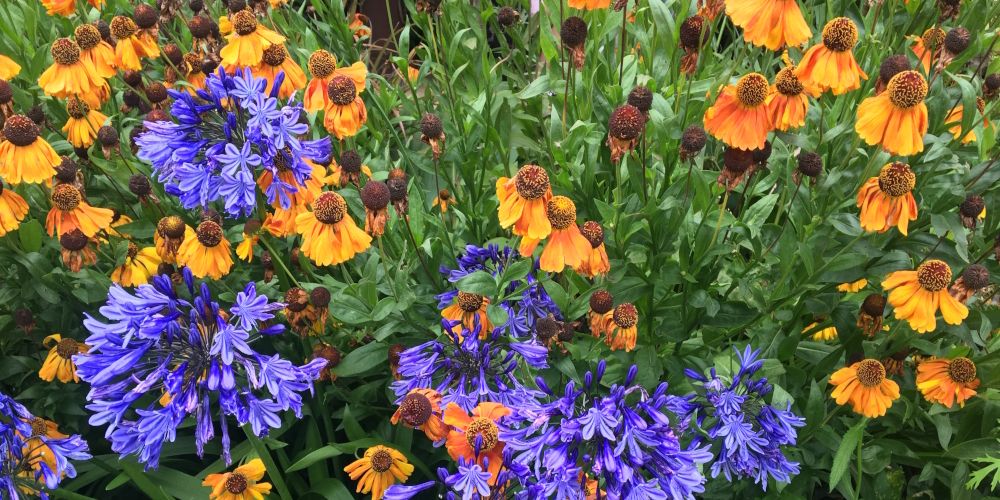
Geranium, red Geum and Primula
This is a lovely, bright early summer flowering combination of Geranium with candelabra primula and Red Geum.
Easy to grow herbaceous perennials which will return reliably each year. Tolerant of some shade, and not too fussy about growing conditions. In terms of maintenance, both Geranium and Geum will benefit from dead heading to prolong flowering. On a personal note, I think red Geum is much better than the yellow variety.
Allium, Achillea and Grasses
Grasses mix really well with many garden plants, illustrated here Deschampsia with the late summer flowering Allium sphaerocephalon and Achillea. In the image at the top of grasses is combined with Dierama pulcherrimum (common name angel's fishing rod,) with Agapanthus. Grasses mix well and more for ideas about mixing Ornamental grasses page and images to inspire on Pinterest below.
Climber combination Honeysuckle and Clematis
This is a summer scented combination of two climbing plants, Lonicera common name Honeysuckle and Clematis fargesioides. A light creamy white combination which is medium easy to grow, with the bonus of lovely scent.
Both are quite tall and vigorous climbing plants which will need a large plant support and can be kept in check by pruning.
Lychnis, Alchemilla, and more
A lovely strong flowering combination includes lime green Alchemilla, Magenta Lychnis coronaria (also known as Rose Campion) whose color is picked up and reflected in the dark red Peony on the left. An unusual deciduous pink flowering Ceanothus provides the contrasting pale pink.
Thalictrum and Cotinus
Thalictrum is one of the best, and easiest of garden perennials, which look looks good with the dark purple shrub Cotinus, this variety illustrated is C. Coggygria Purpurea - The Purple smoke bush. Thalictrum is a tall plant with clouds of fluffy mauve (or white flowers). It will grow through and up into the Cotinus, which can also act as a support. An easy to grow, fully hardy combination. Cotinus needs full summer to flower well.
Delphinium and Thalictrum
Delphinium and Thalictrum are a heavenly summer combination. Illustrated here is T.Alba with a dark blue Delphinium.
Even though Thalictrum is tall, it does not need too much staking. Delphiniums are demanding, a red wheelbarrow plant but a great combination, if you have the inclination.
Bee friendly combination Helium, Monarda Hyssop
A lovely bright summer combination of Helium, Monarda and Hyssop, which has the bonus of being very bee friendly. The Monarda and Hyssop are aromatic and loved by bees. This combination is of herbaceous perennials and may require staking and also cutting back at the end of the growing season. During the summer, it provides a long season of colour and will positively hum with bees.
Soft blues Nepeta and Artemisia
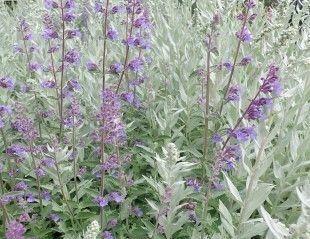
Soft greys and muted blue makes this a winning combination. The small shrub Artemisia is combined with Nepeta (common name Catmint). Not all Artemisia is as soft grey as this one, which is A. Valerie Finnis. Both are easy to grow and require no maintenance. Together they make great edging plants around a border. If you prefer not to use Nepeta, you have the option to substitute it with Lavender for a very similar effect, given that the conditions are suitable. A drought tolerant combination.
Cottage garden Digitalis, Foxglove and Delphinium
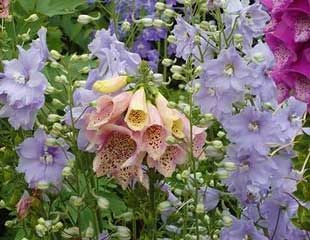
A cottage garden planting combination for summer. This is a lovely mix of Delphiniums and Foxgloves. The soft apricot of the Foxglove, Digitalis 'Sutton's Apricot' with pale blue Delphiniums, looks excellent. Foxgloves are biennial, which means they form one year and flower the next. However, as they are good self seeders, they reappear each year as if they were annuals.
Crocosmia Lucifer with Allium sphaerocephalon
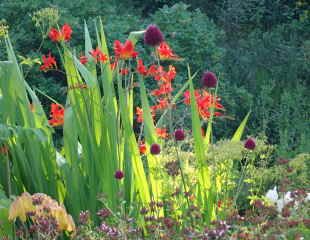
Rose sweet Juliet and Leucanthemum
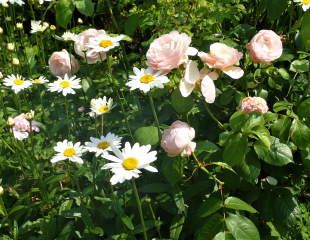
Soft peachy colours a lovely summer combination of a highly scented Rose 'Sweet Juliet' and the white daisy flowers of Leucanthemum. Simple but effective.
Roses are not straightforward to grow but very rewarding, the Leucanthemum is an easy to grow perennial returning reliably each year.
Blue geranium, pink Lychnis& rose

A Blue hardy geranium, combined with magenta pink Lychnis coronaria, common name rose campion, and just a hint of pale pink rose . A lovely summery combination this image was taken at Neville Holt Hall Garden.
Gladiolus, Nasturtium
This is an unusual combination of Orange tinged red Gladiolus with a carpet of orange nasturtiums. The eagle eyed view may also have spotted onions and Kale growing around the flowering plants.
I took this image at the Easton Walled Garden and in situ it was really lovely.
Attractive Veg combinations

Vegetable displays can make very attractive combinations in the garden. In this garden, lettuces have been planted in contrasting red and green varieties, with a backdrop of red and yellow nasturtiums.
Image taken at Barnsdale Gardens. This is a garden which prides itself on 37 separate gardens where you can see many planting styles and combinations.
Decidous pink Ceanothus

This summer planting combination is pink deciduous Ceanothus x pallidus with cerise lychnis coronaria, and Alchemilla mollis.
Herbaceous combination

This lovely summer combination is pink Lythrum, blue echinops, red crocosmia and white veronicastrum.
Simple, but effective

A simple summer combination of Lychnis coronaria growing against the sword like foliage of Crocosmia



